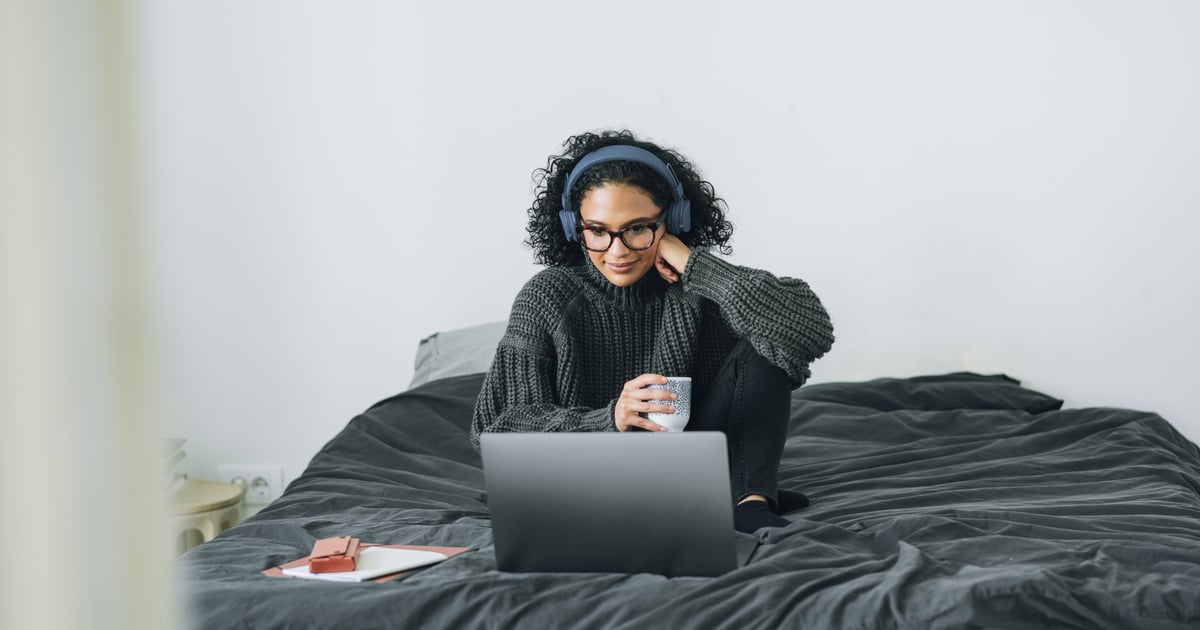Products You May Like

A hard truth that I (and probably many others) have had to face in the past two years is that working from bed is not a sustainable habit. And believe me, I tried to make it work: when I started working from home full time in 2020, I spent weeks logging on from the comfort of my pillows and fluffy comforter. I grabbed my laptop in the morning, curled up under the covers, and started my day, only getting out of bed for bathroom breaks and cups of tea.
A year and a half later, I was in physical therapy for pelvis-alignment issues, which were caused in part by poor workday posture. My physical therapist strongly discouraged working in bed, which I’d mostly stopped doing anyway by that point (it turns out that staying in your bed 24 hours a day gets boring after a while). Now, if I spend even half a day working in bed — even while adding extra lumbar support and sitting up as straight as possible — I feel the effects the next day, with pain flaring up in my lower back.
With more of us working and learning from home in this COVID-transformed world, I know I’m not the only one wondering whether there is any posture or position that makes working in bed tolerable for your body. According to Supreet Shah, DC, MS, CCSP, a chiropractor at TruSpine in San Francisco, there actually is — you just need a few extra pillows to make it happen.
Is Working From Bed Bad For Your Back?
It’s “really, really tough” to maintain good posture when you work from bed, Shah tells POPSUGAR. That’s because, compared to a chair, even the most comfortable mattress tends to be less supportive and more uneven, which can lead to issues with slouching and improper alignment in your hips and spine. “We’ll end up sinking into the mattress,” Dr. Shah explains. The soft surface and lack of support both beneath your butt and behind your back inevitably causes a rounding of the spine, which stresses the muscles in your back. (While some doctors say you can work lying flat on your back without straining your back, this position isn’t as realistic for those of us who use laptops.)
In the moment, or over a shorter period of time (say, an hour or two instead of six or eight), it might feel comfortable to lean back against your pillows with your laptop propped up on your lap. But the longer you stay in that position — back and shoulders rounded, weight unevenly distributed on the mattress — the more you’re overstretching the muscles in your back. Then, when you stand up and use those muscles, “there’s a higher tendency to throw out your back or something kind of getting pulled,” Dr. Shah says. “It puts your spine and your back at a more of a vulnerable positioning if we’re in our beds all day.”
Separate from your spine health, it’s worth noting that sleep experts also discourage working from the bed, as it causes your brain to associate your bed with work instead of sleep. That may make it harder to wind down at night when you’re actually using your bed for snoozing.
How to Work From Bed With Good Posture (and No Back Pain)
Dr. Shah doesn’t recommend working from bed, but if you have to use your mattress as a workstation for the day (or you just really prefer it to a desk or table), he suggests the following setup to lessen the stress on your back. All you need are four pillows — preferably large, firm, and supportive (like typical sleeping pillows, rather than throw pillows). Here’s what to do:
- Place a pillow behind your back vertically. This pillow will help you maintain some of the natural curvature of your spine so you don’t hunch forward as much. Place it lengthwise along your spine and against the headboard or wall behind you.
- Place a pillow below your butt. This pillow should go horizontally underneath your butt and the backs of your thighs to provide extra support and a slightly firmer surface to sit on, as well as to “keep a little bit of pressure off the back,” Dr. Shah says.
- Put another pillow horizontally under your knees. This pillow brings your knees into a flexed position. This allows your hamstring muscles to relax, “which, in turn, pulls less on the lower back,” Dr. Shah says.
- Place the last pillow against your chest and under your arms. The last pillow goes between your chest and your arms, giving your elbows and upper arms a place to rest. It should feel like you’re gently hugging the pillow between your triceps and chest while keeping your forearms, wrists, and hands free. This is to prevent your arms and upper body from caving in over your screen, Dr. Shah says: “Having that pillow to rest your arms on keeps your arms at more of a neutral positioning.”
The idea is that these pillows should “keep your body and your spine in more of a neutral position,” Dr. Shah says, so that the muscles in your back don’t get strained or overstretched and set you up for pain or injury. You can set your laptop on your lap, another pillow, or a lap desk or laptop stand (Dr. Shah recommends the MOFT laptop stand). It’s ideal to have your screen at eye level, he says, but that likely won’t be possible if you’re working in bed. Using a laptop stand is a “good alternative.”
These tips are meant to lessen the strain on your back if you have to work from bed, but as a general rule, a sturdier seat is always better. “A sturdy chair that’s not too cushiony — that would be a good option for longterm support for the spine,” Dr. Shah says. And no matter what sitting position you choose, if you work at a sedentary job, make sure to take breaks to stand up, stretch, or even roll out your muscles with a foam roller. Still experiencing back pain even with a solid ergonomic setup? Consider making an appointment with a doctor or a chiropractor to see what’s going on with your posture and positioning. “[Chiropractors] can help reduce pain levels,” Dr. Shah says. “But we can also give you more [personalized] tips, because each person’s body is unique.”
